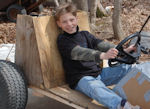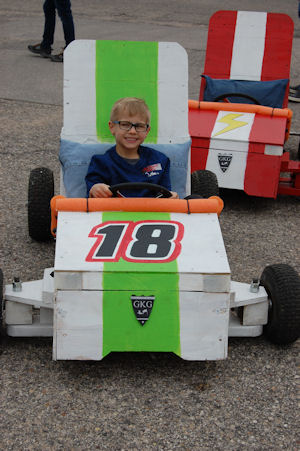Very often we go to an old farm and see a lawnmower sitting in the backyard or we see an old chainsaw sitting on the shelf in the back shed.
The thought goes through our head:
”It would be great if we could take that engine and use it on a go kart.”
It is a great idea, however, there are some unseen problems with these engines. The culprits to engines can be summed up in the following:
– Rodent infestation
– Rusty components
– Corroded aluminum components
– Clogged up carburetors
The rodent infestation can actually be the most damaging and the least obvious. Often times the rodents will infest themselves in any hole or port. The most common port is the exhaust port. Typically the intake port will not have rodent problems because of the carburetor valves.
If the engine is left alone but the valves are open during dormancy, rodents can get inside the engine and leave all sorts of seeds, grains and nest material. The biggest space than a rodent can get in and actually make in mass is underneath the blower housing.
The damage that a rodent makes it is most often eating wires and hoses. Typically the wires they will eat will be the ground wire and these plug wire. Usually the damage is the installation is chewed away and the wire is left bare. Sometimes all that is required is that the wire be covered with electrical tape to simulate wire insulation.
The other downside to rodents getting inside an engine is the acid from their urine and will cause corrosion and rust.
The Rusty components usually manifest themselves in the two areas:
– The Flywheel
– The Governor/Carburetor Linkages.
Rust usually develops on the flywheel surface causing the magnet and the magneto to collide. Care should be taken when cleaning off the flywheel so that the magnet inside the flywheel is not reduced in strength. The carburetor and governor linkages are usually rusty and can be repaired by spraying oil penetrant or rust penetrant lubricants on the linkage areas. Care must be taken so that the linkages are not stressed and the parts break due to being wrenched on.
The corroded aluminum components usually manifest themselves in any area where the bolts are mounted to the engine block. Usually the component will become corroded and rusted, so care should be taken to put some penetrant into the bolt/aluminum interface before trying to loosen the bolt. Also use of impact tools is not recommended when disassembling an aluminum block engine, because the corroded aluminum parts will tend a crack and break.
It is almost a given that the carburetor will be corroded and rusted internally if it has been sitting on an engine for more than one year. It is advisable that the carburetor be taken off the engine and cleaned prior to even trying to start the engine, especially the engine that has been sitting around for more than a year and a half or so.
Bottom line is that if you are finding an old engine sitting in someone’s backyard, figure that you should be taking it apart before even consider trying to run it on a go kart.
Don’t be surprised if you see mouse nests, chewed on wires, broken hoses, broken wires, rusted flywheels, rusted carburetor linkages, and clog up carburetors. Usually the most engine disassembly that is required is to remove the cylinder head and inspect cylinder walls for excessive scoring. Typically an engine will not be frozen solid and that is a good sign.
The engine can be reconditioned but will require at least 6 to 7 hours of disassembly and cleaning. The carburetor alone will require at least three of four hours worth of cleaning and adjustment.
For more information on how to actually mount a vertical engine, or a lawnmower engine from any riding lawnmower onto a go kart referred to our go kart building 202 series, which includes the go kart building 201 engine drives course as well.
One of the biggest questions people ask is:
– How much power is required to actually make my go kart move?
The other question is:
– Will this engine that I’m looking at even have enough power to run a go kart?
The Go Kart Guru in 201 course in conjunction with the engineering toolkit on the Go Kart Guru webpage helps answer these questions.



Is there a good replacement engine for the Shriners Tin Lizzy ?
The original was a 3hp briggs.
The modern overhead valve engines that are 3.5 horsepower are more than adequate for the Model T 10 McDonough Tin Lizzy gokarts. One thing to remember though is that you need to put the engine in backwards to work with the existing transmission. Also, typically users will have to space up the engine to clear the body adequately and to line up with the old existing engine shaft center-line so that the reverser system works correctly.